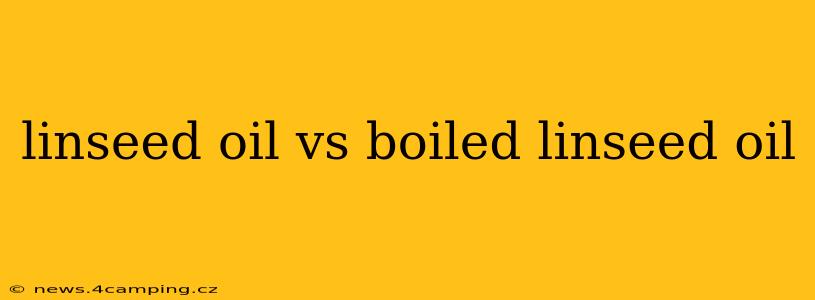Linseed oil, derived from flax seeds, is a popular drying oil used in various applications, from painting and varnishing to wood finishing and even as a dietary supplement. However, there's a crucial distinction between raw (or pure) linseed oil and boiled linseed oil, and understanding this difference is key to choosing the right product for your needs. This article will delve into the specifics, answering common questions surrounding these two variations of linseed oil.
What is the difference between linseed oil and boiled linseed oil?
The primary difference lies in the processing. Raw linseed oil is simply the oil extracted from flax seeds, with minimal processing. Boiled linseed oil, on the other hand, undergoes a process that accelerates its drying time. This "boiling" doesn't involve actual boiling; instead, it involves heating the oil with metallic driers like cobalt, manganese, or lead (although lead-based driers are less common now due to toxicity concerns). These driers act as catalysts, speeding up the oxidation process that allows the oil to harden.
What are the pros and cons of each type?
Raw Linseed Oil:
Pros:
- Slower drying time: This allows for more working time, beneficial for techniques requiring extended blending or smoothing.
- Penetration: Raw linseed oil penetrates wood more deeply than boiled linseed oil, offering better protection and nourishment.
- Less chance of yellowing: Although all linseed oil will yellow over time, raw linseed oil tends to yellow slightly less.
Cons:
- Longer drying time: This can be inconvenient for projects requiring a quicker turnaround.
- Requires multiple coats: Due to slower drying, achieving a protective layer usually requires multiple applications.
Boiled Linseed Oil:
Pros:
- Faster drying time: This is ideal for projects where speed is essential.
- Better for creating a film: The faster drying results in a more durable, protective film.
Cons:
- Less penetration: It doesn't penetrate wood as deeply as raw linseed oil.
- Greater chance of yellowing: The addition of driers can potentially accelerate yellowing.
- Potential toxicity concerns (depending on driers used): While lead-based driers are less common, always check the product label for safety information.
Is boiled linseed oil dangerous?
Boiled linseed oil itself isn't inherently dangerous, but it's crucial to be aware of the potential hazards. Older formulations may contain lead driers, which are toxic. Even modern formulations can pose a risk of spontaneous combustion if rags or brushes soaked in boiled linseed oil are improperly disposed of. Always ensure adequate ventilation when working with linseed oil and properly dispose of oil-soaked materials to prevent fire hazards.
What is the best type of linseed oil for wood finishing?
The "best" type depends on your specific project. For deep penetration and nourishment, raw linseed oil is often preferred, particularly for fine furniture or valuable wood pieces. However, you should be prepared for longer drying times and multiple applications. For faster drying and a more durable surface, boiled linseed oil might be a better choice for projects where time is a factor.
Which linseed oil is best for painting?
For painting, boiled linseed oil is generally preferred due to its faster drying time. The quicker drying prevents the paint from becoming tacky for too long. However, the choice depends on the specific paint type and the desired finish. Always refer to the paint manufacturer's recommendations.
Can I use boiled linseed oil on my skin?
No, boiled linseed oil is not recommended for skin application. While raw linseed oil is sometimes used topically for its purported benefits, the added driers in boiled linseed oil make it unsuitable for skin contact. Stick to specialized skin products for skincare routines.
By understanding the differences between raw and boiled linseed oil, you can make informed decisions about which product best suits your specific needs and project requirements. Remember always to prioritize safety and proper disposal of oil-soaked materials.
